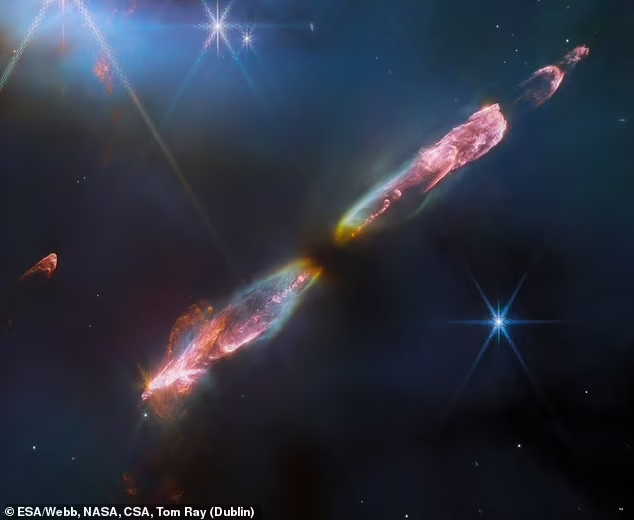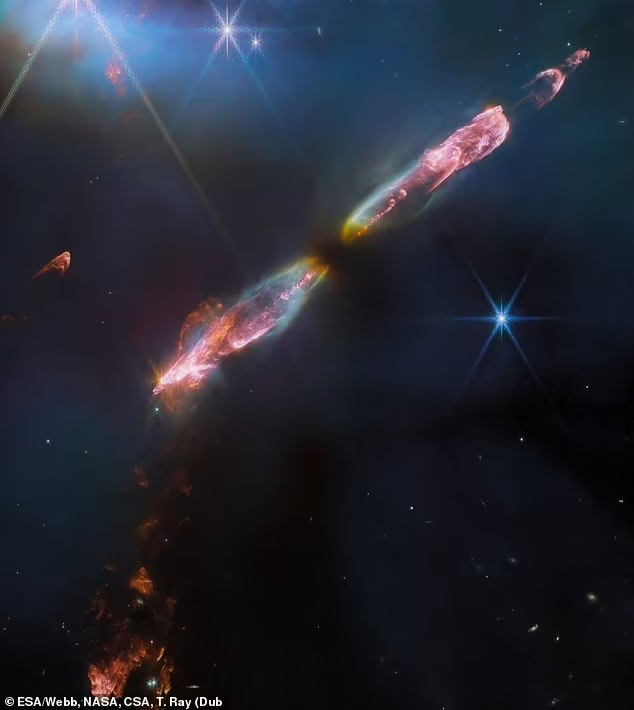James Webb snaps ‘Star Wars lightsaber’ glowing out of the newborn sun-like star

This stunning depiction of a nascent star, complete with a luminous ‘lightsaber’ reminiscent of Star Wars, may appear to be from a distant galaxy. However, it is in fact closely linked to our own solar system, as it provides a glimpse into the early stages of our sun’s formation.
Herbig-Haro 211 (HH 211), situated approximately 1,000 light-years away from Earth in the Perseus constellation, is not discernible in the image obtained by NASA’s James Webb Space Telescope. Nevertheless, astronomers have ascertained its presence due to the substantial outflows of gas and dust emanating from both sides of the star, indicating its growth. Presently, HH 211 is approximately eight percent of the sun’s mass, but it is anticipated to attain the same magnitude in the next few million years.
 The near-infrared camera on the Webb telescope has captured unprecedented detail of the bipolar jets emanating from the protostar, HH 211. This has allowed for extensive analysis, which suggests that the star is only a few thousand years old. The images have also revealed that the jets are mostly comprised of molecules, including carbon monoxide, silicon monoxide, and molecular hydrogen. This was unexpected, as similar bipolar jets are typically made up of individual atoms or ions. However, the slower flow of gas and dust from HH 211 means that there is not enough energy in the jets to break the molecules apart into simpler atoms and ions.
The near-infrared camera on the Webb telescope has captured unprecedented detail of the bipolar jets emanating from the protostar, HH 211. This has allowed for extensive analysis, which suggests that the star is only a few thousand years old. The images have also revealed that the jets are mostly comprised of molecules, including carbon monoxide, silicon monoxide, and molecular hydrogen. This was unexpected, as similar bipolar jets are typically made up of individual atoms or ions. However, the slower flow of gas and dust from HH 211 means that there is not enough energy in the jets to break the molecules apart into simpler atoms and ions.
The reason for the slower jets remains a mystery. The lead author of the research, Professor Tom Ray, of the Dublin Institute for Advanced Studies, explained that the highly supersonic beams of matter emitted by new stars can stretch for several light-years and resemble Star Wars lightsabers. These beams shine with light from many different atoms and molecules, making them difficult to spot from Earth. However, with the help of Webb’s infrared light, astronomers are able to penetrate through the gas and dust and reveal stellar births or stars like HH 211.
Through groundbreaking discoveries such as this, we are enhancing our comprehension of the birth of celestial bodies, thereby advancing our knowledge of the origins of our sun and the solar system.
An intriguing revelation from this latest image is that newly formed stars emit extremely supersonic matter beams that can extend for numerous light-years.
Furthermore, the study indicates that nascent stars emit beams consisting of nearly pure molecules, which move at a sluggish pace, contrary to previous astronomical assumptions. The mechanism behind the production of such beams without the presence of atoms and ions remains a mystery.
The findings of this research have been published in the esteemed journal, Nature.









